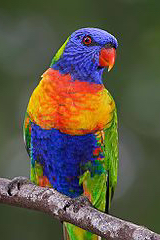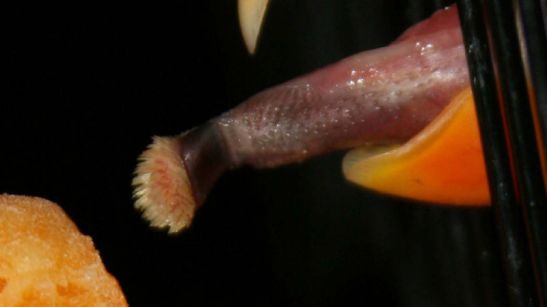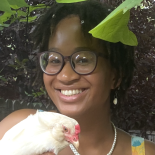Some Fun Facts About Our Friend the Rainbow Lorikeet
New birds have joined the Exotic Bird Emporium, including three Rainbow Lorikeets! Their names are Penn, Teller and Daphne (the latter of which is at the Colorado Springs location). Originally, Penn and Teller were supposed to be a breeding pair, but it was later found out that they were in fact both males! Daphne is the only female of the bunch.

A picture of one of the rainbow lorikeets in their cage!
I thought it might be fun to share some interesting facts about the Rainbow Lorikeet—see if you know them already!
General Facts-
Although the Rainbow Lorikeet receives most of the attention, there are actually several species under the common names of Lory and Lorikeet (they are all a part of the subfamily Loriinae), including the red lory, black lory, and chattering lory. It’s easy to guess the reason for the rainbow lorikeet’s popularity—it’s bright color.
The Rainbow Lorikeet comes from Australia, and they are much more likely to be seen in the wild there.
In people’s minds, Lorikeets are viewed as similar to parakeets because both have a smaller size compared to other birds, however, there are many differences between the two bird categories, such as color, temperament and speaking ability.
True or False?-
One common misconception about Lorikeets—and birds in general–is that they can survive on a diet of just nuts and seeds, like sunflowers. If you are surprised that this is a myth, go check out my last post: A Lesson in Malnourishment and Healthy Eating for Birds. This actually couldn’t be further from the truth–especially in the case of the Rainbow Lorikeet. In its natural habitat, the Rainbow Lorikeet actually eats the pollen/nectar of flowers, as well as berries and fruits.
Personality-
Rainbow lorikeets are described as having similar temperament to that of caiques (my favorite bird!) and are considered the clowns of the bird world. They are noisy, entertaining, and mischievous birds with a good sense of humor. This is another key difference between parakeets and lorikeets—parakeets are much more skittish and are more likely to be considered “cage birds” (see my post here about common bird classification). Lorikeets are quite unique in this way, and they are even described as being relatively friendly in the wild as well. However, like all birds, you can never underestimate their biting and scratching ability–especially when putting them in or taking them out of their cage.

The Lorikeet’s Special Secret-
In addition to its unique personality, Rainbow Lorikeets have mad skills: they can hang upside down and fly in ways that make it easier to reach the flowers high in the trees and bushes. Despite that, you may still be wondering how the lorikeet— which doesn’t exactly look or function like most other nectar-eating animals such as hummingbirds or butterflies–eats its sugary fill of flower pollen. This parrot has a secret! It actually has little “brushes”—papillae— at the end of its tongue that help it grab nectar from inside the flowers.

Check out the cringe worthy papillae on the Rainbow Lorikeet’s tongue. Pretty cool!
Picture from this article: https://io9.gizmodo.com/this-is-what-a-lorikeets-tongue-looks-like-that-is-all-30762282
Come by to see the rainbow lorikeets today!
